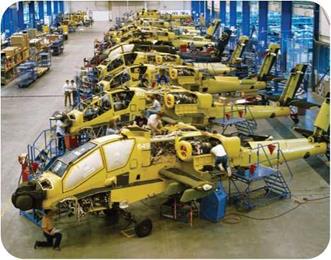Industry Beginnings
In the early days of the airplane industry, engineers constructed airplanes in
|
![]()
![]()
A new aircraft starts life as a design on paper or on a computer screen. A manufacturer may plan a new model, such as an airliner or helicopter. Alternatively it may update an existing model, perhaps by lengthening the fuselage or giving it more powerful and more efficient engines. The manufacturer then offers the new product to the world market, by showing it at air shows, for example. (Air shows bring new products and and potential buyers together and they are open to the public as well.)
Other aircraft are commissioned by customers. The U. S. Department of Defense asks manufacturers to submit plans for new aircraft or missiles, setting out such details as size, speed, cost, and mission tasks. Sometimes, two or more prototypes are tested in competition. In the late 1980s, the U. S. government invited Boeing and Lockheed Martin to submit designs for an important new military airplane, the Joint Strike Fighter. This was a complex, multipurpose airplane, intended to replace not just one existing airplane but several different models. Both companies put forward a design, and Lockheed Martin’s F-35A won the contract. This decision will affect thousands of aerospace industry workers, since the new plane will probably be in service for at least thirty years from its scheduled release date of 2011.
 A new plane is thoroughly tested-sometimes for years-before it is ready to go into production. Few aircraft fly perfectly the first time, and many modifications may be made before airplanes start to roll off the assembly lines.
A new plane is thoroughly tested-sometimes for years-before it is ready to go into production. Few aircraft fly perfectly the first time, and many modifications may be made before airplanes start to roll off the assembly lines.
Most airplanes are now built, like automobiles, on a production line. Aircraft are rarely built on one site, however. Instead, subcontractors build different parts of the airplane, such as the wings and tail. Manufacturers select the engines from a specialized engine maker, such as GE-Aviation. The parts of the plane, with all of its electronics and other fittings, are then brought together and assembled at a large manufac – О Apache helicopters are assembled at a Boeing plant turing plant. in Mesa, Arizona.
![]()
small sheds. They used their own skill and ideas, plus what they read about other inventors’ “flying machines.” Orville and Wilbur Wright, for example, were bicycle engineers. The brothers built their first planes in the early 1900s just to see if they could fy.
Glenn Curtiss, another aviation pioneer, set up America’s first airplane manufacturing company in 1907. In 1909 two competitors entered the business field: the Wright brothers and Glenn L. Martin.
At first, all planes were built one at a time. Series production began in 1909, when the Short Brothers factory in the
f © s
MILITARY CONTRACT
The first contract for a U. S. military plane was awarded to the Wright brothers in 1907. Unfortunately, the aircraft crashed on September 17, 1908. Orville Wright, the pilot, survived, but his passenger, Lieutenant Thomas E. Selfridge of the U. S. Army Signal Corps, was killed. This was the first fatal accident in a powered airplane. In spite of the accident, the Wrights’ biplane was accepted by the U. S. Army. The brothers were even paid a bonus, because their plane flew 2 miles per hour (3.2 kilometers per hour) faster than the 40 miles per hour (64.4 kilometers per hour) the U. S. Army had requested.
_____________________________________________ J
United Kingdom built six identical Wright biplanes.
Before World War I (1914-1918), airplanes were built almost entirely by hand. They were made chiefly of wood, fabric, and wire. Furniture makers had the skills to build airplanes, and in wartime, some furniture factories switched to aircraft manufacture. By adopting the assembly line methods of automobile manufacturers such as Ford, aircraft companies were able to build planes faster. Two important names in aerospace history, Boeing and Lockheed, started building aircraft in 1916. By the end of World War I, U. S. factories had built more than 14,000 military planes.
After the war, more manufacturers started to supply aircraft for the fastgrowing civil aviation industry. Airline businesses were just beginning, and they needed airplanes. The first U. S. international scheduled airline service was in 1919, operated by Aero Marine West Indies Airways between Key West, Florida, and Havana, Cuba. In the 1920s, companies entering the airplane manufacturing industry included Douglas (1920), Pratt & Whitney (1925), and Grumman (1929).











